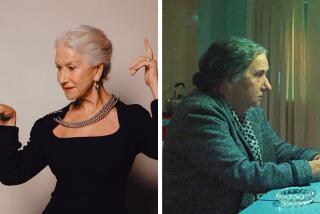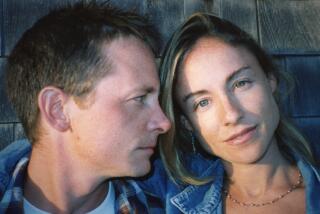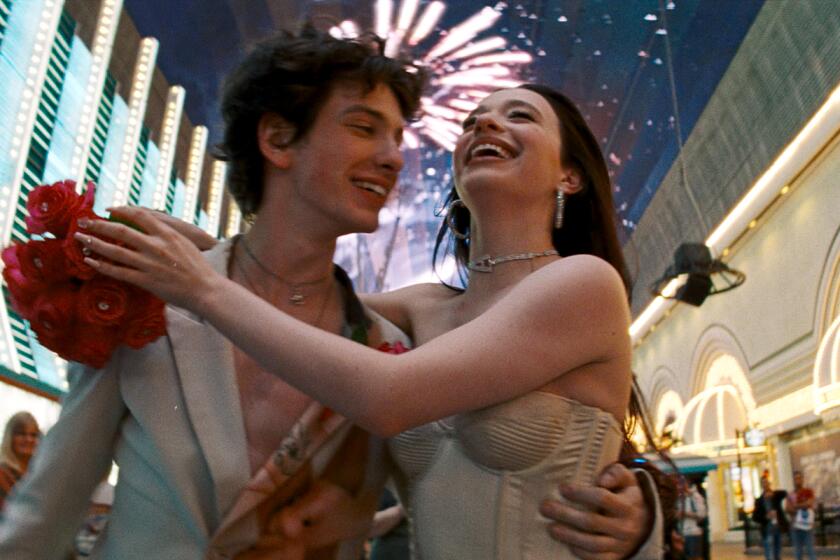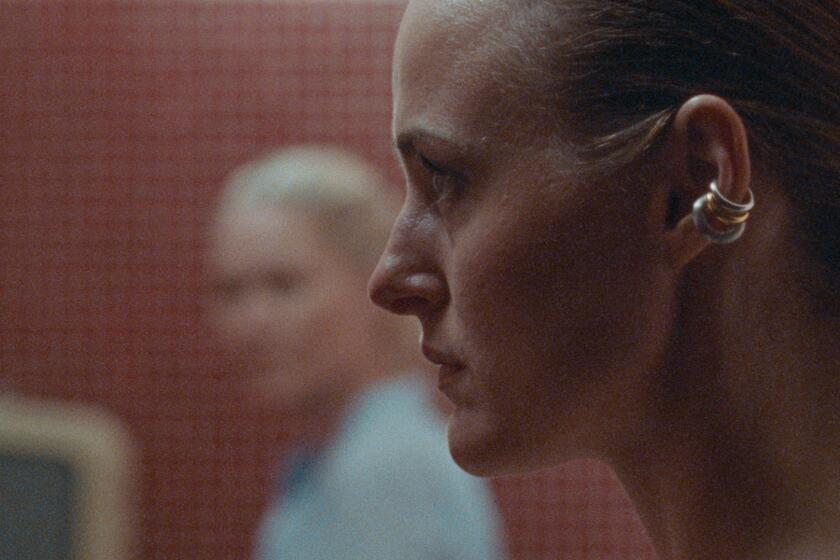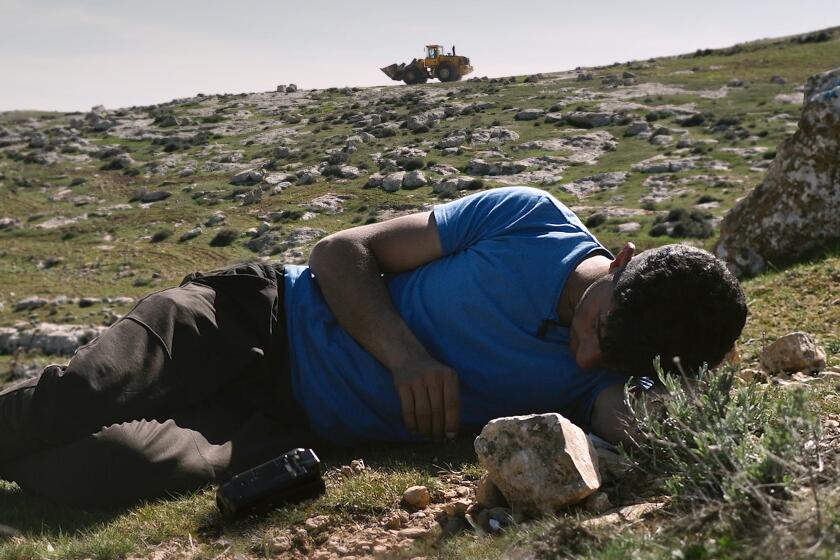Platinum power
- Share via
Even with her au courant designer outfits -- her dog Bruiser is always in coordinated attire -- Elle Woods, the irrepressible heroine played by Reese Witherspoon in the just-released sequel “Legally Blonde 2: Red White & Blonde,” is steeped in the tradition of the not-so-dumb blonds of the 1930s, such as Jean Harlow and Carole Lombard.
Like the blond-haired characters created by Harlow, Lombard and Barbara Stanwyck in such films as “Dinner at Eight,” “My Man Godfrey” and “The Lady Eve,” Elle is the catalyst of both “Legally Blonde” movies. Because of her trendy outfits, blond hair and little-girl voice, she is often mistaken for a living Barbie doll. But she knows who she is and what she wants, and although she has moments of self-doubt, her anxieties are short-lived due to her strong determination.
For the record:
12:00 a.m. July 20, 2003 For The Record
Los Angeles Times Sunday July 20, 2003 Home Edition Sunday Calendar Part E Page 2 Calendar Desk 0 inches; 33 words Type of Material: Correction
Michelle Pfeiffer -- In the July 6 Sunday Calendar, an article about the history of blonds in movies said that Michelle Pfeiffer had won an Oscar. She has been nominated but hasn’t won.
For The Record
Los Angeles Times Tuesday July 22, 2003 Home Edition Main News Part A Page 2 National Desk 0 inches; 33 words Type of Material: Correction
Michelle Pfeiffer -- In the July 6 Sunday Calendar, an article about the history of blonds in movies said that Michelle Pfeiffer had won an Oscar. She has been nominated but hasn’t won.
In the new film, not only does Elle find time to plan her wedding and change the lives of several lonely people, she also takes on the bureaucracy in Washington, D.C., and gets a bill through Congress to stop animal testing by cosmetic companies.
Film historian Cari Beauchamp says the first film -- a surprise summer hit two years ago -- had a solid feminist agenda. “Her priorities are so clear,” Beauchamp says. “There are self-worth issues. Women are taking care of women. Women who are friends are really important to each other and they have to love each other first. All of that with this veneer of lip gloss and the Guccis and last year’s Prada.”
Blonds -- smart, dumb and otherwise -- have, so to speak, deep roots in movie history. The first true “blond” character in movies, says Beauchamp, was actually a brunet -- Gloria Swanson -- in the Cecil B. DeMille sex comedies “Male and Female” and “The Affairs of Anatole,” made in the late teens and early ‘20s. “It was the end of the war and the Jazz Age is just starting,” Beauchamp says. “Prohibition is coming in. In terms of the film, she was the first full-blooded blond character.”
Writer Anita Loos added a certain va-va-voom to the blond persona in “Gentlemen Prefer Blondes,” her 1925 bestseller that followed Lorelei Lee, a blond who “usually gets what she wants” and prefers diamonds to kisses. Lorelei was brought to life by Carol Channing on stage in the late ‘40s and by Marilyn Monroe in the 1953 film. Just like Elle, everybody treats Lorelei “like a dummy,” Beauchamp says. “But she’s as smart as a whip. She’s the ditzy blond who knows exactly what she’s doing.”
They didn’t hit their stride until the 1930s, but Harlow, Lombard and Jean Arthur began honing their blond personas in movies in the late ‘20s. These actresses, Beauchamp says, created characters who had “that spunk, that pizazz. They walked into the room and they turned heads.”
Marion Davies was another early actress who played the “dumb” blond. Although her boyfriend, newspaper magnate William Randolph Hearst, kept casting her in serious dramas, Davies excelled in comedies as the girl who knew what she wanted, especially in such silent comedies as “Show People” and “The Patsy” (both from 1928).
Monroe continued that tradition in the 1950s, as did Judy Holliday, who won the Oscar as Billie Dawn, the platinum-haired mistress of a mobster who decides to better herself in “Born Yesterday” (1950). Billie Dawn, Beauchamp says, is the kind of fabulous female protagonist who values herself.” Holliday played variations of that character during her short-lived movie career, especially in her last film -- the 1960 musical “Bells Are Ringing.”
Goldie Hawn began perfecting a similar character as the giggly blond on “Laugh-In” in the late 1960s and parlayed it into a best supporting actress Oscar for her first film, “Cactus Flower” (1969), in which she played a blond free spirit and mistress of a dentist (Walter Matthau). Even in her most recent film, “The Banger Sisters” (2002), Hawn is playing a fiftysomething version of her “Cactus Flower” blond.
Her daughter, Kate Hudson, who began her career as a brunet, has followed in her mom’s footsteps, notably in this year’s “How to Lose a Guy in 10 Days”: She plays a writer who pretends she is a stereotypical blond for a story on all the stupid things women do to drive a man away.
There are many variations of the blond character. Though the blond comediennes dominated the 1930s, Bette Davis actually began her career as a dramatic blond at Warner Bros., winning her first Oscar as an alcoholic actress on the skids in “Dangerous” (1935). But after appearing in “The Petrified Forest” (1936) as a blond, she reverted back to her natural brunet hair color. She didn’t play blond again until “What Ever Happened to Baby Jane” (1962), in which she appeared as demented former child star.
With “High Noon” (1952), Grace Kelly ushered in the blond that no one ever thought of treating like a ditz. Her sophistication, intelligence and flair caught the eye of Alfred Hitchcock, who cast her in three of his classic films, “Rear Window” and “Dial M for Murder” (both 1954) and “To Catch a Thief” (1955).
Before Witherspoon hit it big with Elle, she explored darker aspects of the blond character in such films as “Cruel Intentions,” “Best Laid Plans” and “Election” (all from 1999). Even in last year’s comedy “Sweet Home Alabama,” her blond Melanie Carmichael is dismissive of family and friends in her Alabama hometown she left years before for New York City.
Witherspoon is now in London filming the latest version of William Makepeace Thackeray’s “Vanity Fair.” She plays ambitious Becky Sharp, a poor girl in 1840s London who ascends the social ladder. It’s a role with a rich blond tradition. In 1935, one of that era’s best-known blond actresses, Miriam Hopkins, played that role in the film “Becky Sharp.”
*
(BEGIN TEXT OF INFOBOX)
Blonds’ film history roots
Blond characters in movies come in many shades. Here are a few:
The virginal blond: Mary Pickford and Lillian Gish were the epitome of innocence and chastity during the silent era. (Pickford, who was known as “America’s Sweetheart,” was playing these young-girl roles into her 30s.) But perhaps the best-known virginal blond was Doris Day -- and in Day’s case, the older she got, the more virginal she became. The former band singer started her movie career at Warner Bros. as the perky blond in such musicals as “The West Point Story” (1950), but her image changed forever with the 1959 Rock Hudson comedy “Pillow Talk.” Not only did her hair turn from golden to platinum, it marked the beginning of her persona as a thirtysomething career woman who wanted to remain chaste until she found Mr. Right.
The femme fatale: Although Barbara Stanwyck sported blond hair in several of her film comedies, including the 1941 Preston Sturges classic “The Lady Eve,” she gave her best performance as the seductress with a blond variation of a Prince Valiant haircut in Billy Wilder’s 1944 film noir, “Double Indemnity.” Other blond performers in the femme-
fatale film noir category include Lana Turner in “The Postman Always Rings Twice” (1946), Rita Hayworth in “The Lady From Shanghai” (1948), Glenn Close in “Fatal Attraction” (1987) and Sharon Stone in “Basic Instinct” (1992).
Making-a-statement blonds: Over the years, actors have dyed their hair or donned a blond wig to further define characters. They include Laurence Olivier in “Hamlet” (1948), Marlon Brando in “The Young Lions” (1958), Vivien Leigh in “A Streetcar Named Desire” (1951), Robert Shaw in “From Russia With Love” (1963) and Terence Stamp in “Billy Budd” (1962).
The Hitchcock blond: Alfred Hitchcock had a penchant for cool, sophisticated blond actresses in his films going as far back as Madeleine Carroll in “The 39 Steps” (1935). In the 1950s, Grace Kelly took on that role in “Rear Window” and “Dial M for Murder” (both 1954) and “To Catch a Thief” (1955). Eva Marie Saint took over the mantle in “North By Northwest” (1959) and Tippi Hedren concluded the cycle in “The Birds” (1963) and “Marnie” (1964).
Serious blonds: Oscar winners Joanne Woodward, Meryl Streep, Jessica Lange, Michelle Pfeiffer and William Hurt.
Sex-kitten blonds: The 1950s saw the rise of the sex kitten with France’s Brigitte Bardot in the 1956 film “And God Created Woman.” The phenomenon continued stateside with the likes of Jayne Mansfield and Mamie Van Doren. Pamela Anderson is the latest entry in this category.
Musical blonds: MGM had June Allyson and RKO had Ginger Rogers. But it was 20th Century Fox that had the greatest blond musical performers under contract, including Shirley Temple, Alice Faye, Betty Grable, Carole Landis, June Haver and Marilyn Monroe.
The blond who saved a studio: Just how mighty is the box-office power of a blond? Look no further than platinum-coiffed Mae West. The buxom, bawdy bombshell left Broadway and came to Hollywood in the early ‘30s and saved struggling Paramount Pictures with the success of her naughty pre-Code comedies such as “I’m No Angel” and “She Done Him Wrong.”
More to Read
Only good movies
Get the Indie Focus newsletter, Mark Olsen's weekly guide to the world of cinema.
You may occasionally receive promotional content from the Los Angeles Times.

